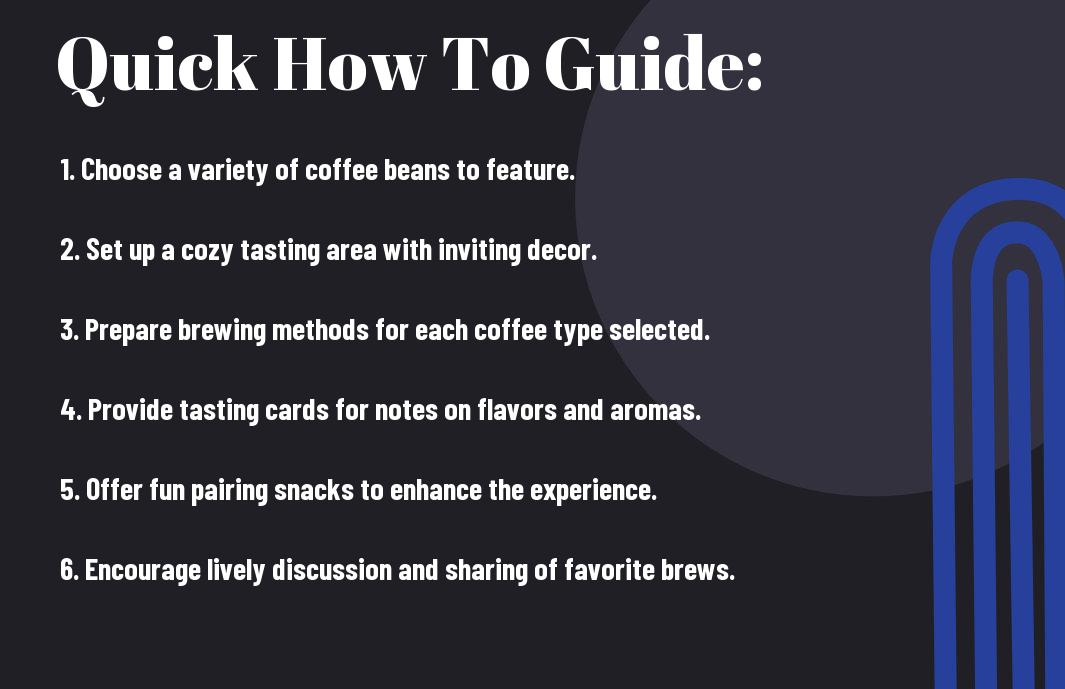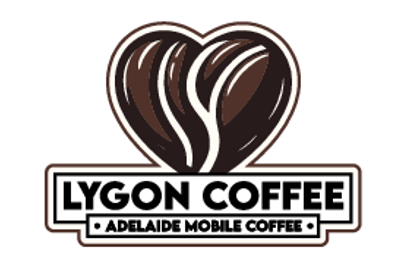Experience the world of coffee like never before with a tasting event that will awaken your senses and engage your guests. In this guide, you’ll discover creative and dynamic ways to showcase different coffee varieties, enhance flavor appreciation, and create an inviting atmosphere. From selecting the perfect beans to designing interactive activities, you will learn everything you need to elevate your coffee tasting experience into a memorable gathering. Get ready to impress your friends and family with your newfound coffee expertise!

How-To Prepare for Your Coffee Tasting
To create an unforgettable coffee tasting experience, it’s important to prepare your space and supplies in advance. Start by choosing a cozy, well-lit area where your guests can comfortably gather. Ensure you have enough seating and table space to accommodate all tastings. Setting the right mood with soft background music can enhance the overall atmosphere, making your coffee tasting feel even more inviting. Use this preparation time to educate yourself about the coffees you’ll be offering, ensuring you can share interesting stories or facts about each variety.
Selecting the Right Coffee Varieties
Some of the most enjoyable moments in a coffee tasting come from exploring diverse flavors and profiles. To make the experience engaging, select a variety of coffee from different regions, roast levels, or processing methods. For instance, include one light roast with fruity notes, a medium roast with chocolate undertones, and a dark roast known for its bold and smoky characteristics. This range will create a dynamic tasting journey, allowing your guests to compare and contrast each cup.
Gathering Essential Tasting Supplies
HowTo effectively host your coffee tasting, you’ll need to gather necessary supplies that enhance the experience. First, make sure you have a selection of tasting cups, ideally small in size to allow for multiple tastings without overwhelming your guests. You will also need access to freshly brewed coffee – consider using a pour-over method for optimal extraction. You’ll find it beneficial to provide tasting spoons for slurping, which helps to aerate the coffee and enhance flavor perception. Finally, having water available for cleansing the palate between tastings will help your guests fully appreciate each coffee.
Right equipment contributes significantly to a seamless coffee tasting. Glass cupping bowls can also be a great addition, allowing guests to slurp their way through coffee without losing ambiance when it comes to taste. Don’t forget to incorporate visual aids such as flavor wheels or tasting cards for guests to jot down their impressions. Setting up an organized and inviting space with these necessarys will elevate your coffee tasting, ensuring guests leave with memorable impressions and newfound knowledge about the world of coffee.
How-To Set the Perfect Tasting Environment
Some of the most memorable coffee tasting experiences are those that take place in a thoughtfully prepared environment. Setting up your space for a coffee tasting involves creating an atmosphere that encourages tasting and conversation. You can find useful tips on How to Host a Coffee Tasting (Cupping) Party. The right environment can enhance both the flavors you discover and the connections you foster with your guests.
Creating a Comfortable Space
You want your guests to feel at ease while they explore different coffee varieties. Arrange comfortable seating with enough space for everyone to gather around your tasting table. Using a round table can encourage discussion and create a more communal experience. Consider adding cushions or throws for added comfort, and make sure to have enough serving tools, like cupping bowls and spoons, to keep things flowing seamlessly.
Managing Lighting and Ambiance
An inviting ambiance can significantly elevate your coffee tasting experience. Use soft, warm lighting to create a cozy atmosphere. Dim overhead lights slightly and incorporate table lamps or candles to achieve a relaxed vibe. Natural light is also effective—if possible, host your tasting during the day when sunlight can illuminate your space without being harsh.
For instance, you can select a time of day when the sunlight softly filters in through a window, enhancing the visual appeal of your coffee selections. Pair the lighting with subtle background music that complements your coffee theme, making the environment feel both engaging and intimate. Feeling at ease and inspired by your surroundings allows your guests to fully immerse themselves in the tasting experience, leading to insightful conversations about the coffee they’re sampling.
Tips for Conducting the Tasting Session
Now that you have gathered your guests and prepared your coffee selections, it’s time to probe the tasting session itself. Setting the right atmosphere is key for a successful experience. Ensure that the space is well-lit and free from strong odors that might interfere with the tasting process. You might consider using neutral, light-colored cups to allow the true colors of the coffee to shine through. Additionally, provide your guests with tasting cards or notebooks to jot down their impressions as they sample each brew. Here are a few more tips to enhance your tasting session:
- Offer a variety of brewing methods to showcase different flavors.
- Encourage participants to take their time and sip slowly.
- Provide a flavor wheel to help guests identify notes in the coffee.
- Engage in discussions about the coffee origins and processing methods.
This will create a more enriching experience that fosters appreciation for the nuances in each cup.
Engaging Guests Effectively
Effectively engaging your guests during the tasting is important for making the experience enjoyable and memorable. Consider starting with a brief introduction about the coffees being tasted, including stories about their origins and unique characteristics. Encourage your participants to share their thoughts and preferences as they taste; this interaction not only prompts exploration but also creates a communal atmosphere where everyone feels welcomed to express their opinions. Use open-ended questions to stimulate conversation, such as “What flavors do you detect?” or “How does this coffee differ from the last one we tasted?”
Additionally, you might want to incorporate mini-games or challenges, like guessing flavor notes blindfolded, to ignite friendly competition. By facilitating an environment where guests feel comfortable sharing and discussing their tastes, you’ll enhance their enjoyment and foster a deeper connection with the coffees offered. Engaging in this way transforms the tasting into more than just an event; it becomes a lively exchange of ideas and experiences.
Encouraging Flavor Exploration
The key to a successful coffee tasting lies in encouraging flavor exploration among your guests. Help them understand that tasting coffee is much like tasting wine; it’s about layers of flavor and aroma. As guests take their first sips, guide them to focus on different aspects of their experience, such as the aroma, acidity, body, and aftertaste. Perhaps suggest they try smelling the coffee before sipping to better appreciate its aroma and how it influences taste.
Session by session, you can introduce different coffee profiles, such as fruity, nutty, chocolaty, or floral. This variation will help your guests identify their preferences while expanding their palate and knowledge. Encouraging dialogue about their perceptions will further heighten their sensory experience as they learn to articulate their feelings about the different coffees. By guiding them to explore beyond the first sip, you’ll deepen their appreciation for the complexities of coffee, leading to a more enjoyable and fulfilling tasting experience.

Factors to Consider When Choosing Coffee
Not every coffee is created equal, and to make your coffee tasting experience truly remarkable, you’ll want to pay attention to a few key factors when selecting your coffee. The choice of beans can significantly influence the flavor notes and overall experience of your tasting. Here are some important elements to consider:
- Bean Origin
- Roast Levels
- Processing Method
- Freshness
- Flavor Notes
After factoring these elements into your selection, you’ll be well on your way to hosting an invigorating and flavorful coffee tasting that sparks conversation and exploration.
Bean Origin and Roast Levels
If you want to dig deeper into the coffee experience, it’s imperative to understand the impact of bean origin and roast levels on flavor profiles. Different regions produce distinct flavors; for instance, Ethiopian coffees typically showcase floral and fruity notes, while Colombian coffees are known for their smooth, well-balanced taste. You’ll want to choose a variety of origins to provide a broad flavor spectrum during your tasting session. Additionally, roast levels—from light to dark—expose a range of flavors as well; light roasts often have brighter acidity and can bring out more of the bean’s unique characteristics, whereas dark roasts tend to be bold and rich.
By selecting a mix of origins and roast levels, you create an engaging contrast for your guests, encouraging them to explore and compare their favorite flavors in an interactive way.
Brewing Methods to Highlight Flavor
Methods of brewing can amplify or mute the characteristics of your selected coffees. Each brewing technique extracts flavors differently, allowing you to customize your tasting experience. For example, a French press emphasizes body and richness, while pour-over methods highlight brightness and complexity. Using various brewing methods can help demonstrate the versatility of each coffee, encouraging your guests to discover their preferences.
Flavor extraction isn’t just about the coffee itself; the water temperature, grind size, and brew time will all influence the final product. Wave brewing styles that might interest your audience include espresso, cold brew, or AeroPress, offering a spectrum of techniques and results that provoke discussion on which method best highlights the characteristics of each coffee. This variety not only enriches the experience but invites your guests to experiment and appreciate coffee at a deeper level.
How-To Evaluate Coffee Like a Pro
All coffee lovers can elevate their tasting game by learning how to properly evaluate their brews. Exploring flavors and aromas is not just an enjoyable experience; it’s a journey that gives you a deeper appreciation of the beverage. You can find tips on How to Host a Coffee Tasting Party at Home – Georgian cuisine to help you kickstart your tasting party with friends. Understanding your coffee can foster meaningful conversations and an exciting atmosphere during your tasting session.
Using the SCAA Tasting Wheel
Some of the most effective professionals use the SCAA (Specialty Coffee Association of America) Tasting Wheel, which lists various flavor and aroma descriptors that can help guide you during your tasting evaluation. Familiarize yourself with the wheel, as it outlines everything from fruity and floral notes to more earthy and nutty undertones. By referencing the wheel, you can enhance your ability to communicate specific tastes with your peers, making discussions about your tasting experience far more insightful.
Flavor Notes and Aroma Assessment
Little things like the aroma and flavor notes will play a significant role in your coffee evaluation. Take a moment to inhale the fragrance of your freshly brewed coffee before tasting it; this initial response can inform your palate. After taking a sip, explore how the flavors evolve—consider the sweetness, acidity, and body of the coffee. Pay attention to the overall finish or aftertaste, as it can reveal even more about the coffee’s quality.
HowTo enhance your flavor notes and aroma assessment is to take notes during your tasting, jotting down descriptions that resonate with you. This practice not only helps you develop your palate but also serves as a fantastic reference for future tastings. Additionally, it allows you to articulate your preferences more effectively, which can be beneficial when selecting coffees in the future.
Tips for Serving Complementary Snacks
Many coffee aficionados understand that the right snacks can significantly enhance your coffee tasting experience. When planning your tasting session, consider offering a variety of treats that complement the distinct flavors and aromas of your selected brews. Here is a list of ideas to get you started:
- Dark chocolate squares
- Assorted nuts like almonds or hazelnuts
- Freshly baked pastries
- Cheese bites (like Brie or sharp cheddar)
- Fruit slices (think apples or berries)
These snacks not only elevate the experience but also provide texture and contrast to the flavors of the coffee. Perceiving the interplay between the snacks and coffee can lead to delightful discoveries for both you and your guests.
Pairing Treats with Coffee
Pairing the right treats with your coffee can elevate your tasting experience to new heights. Consider the flavor profile of the coffee you are serving; for instance, a bright and citrusy coffee pairs beautifully with a light lemon tart or biscotti. Similarly, if you have a rich, chocolatey brew, offering dark chocolate or a chocolate croissant will create a harmonious balance that accentuates the coffee’s depth. Experiment with different combinations to find the pairings that resonate most with your personal tastes and those of your guests.
Keep in mind that every coffee is unique, and experimenting with flavors can lead to exciting discoveries. As you serve different types of coffee, be mindful of each one’s distinct tasting notes, and aim to match those notes with complementary treats that either enhance or contrast what you’re drinking.
Balancing Flavors for Enhanced Experience
Treats can also be selected based on the goal of balancing or enhancing specific flavors in your coffee. If your coffee has fruity notes, you might consider serving something slightly tart, such as a cranberry scone, which can draw out those fruity flavors. Conversely, if your coffee has nutty undertones, a nut-based snack can help to emphasize and deepen that experience, making it richer and more enjoyable for you and your guests.
Another effective strategy is to choose snacks that bring sweetness to the table, such as honey or a light cake, which can offset the bitterness of certain coffee beans. By creating a balance between sweet and bitter, you allow your participants to appreciate the full range of flavors that coffee has to offer. Adjusting the snacks you provide not only enhances the tasting experience but also encourages a more comprehensive appreciation for the complexities of each cup.
Summing up
Now that you have explored various fun and engaging methods to host your own energizing coffee tasting experience, it’s time to put those ideas into action. By carefully selecting a diverse range of coffee beans, incorporating themed pairings, and utilizing sensory experiences, you can create a memorable event that not only stimulates the palate but also strengthens connections among your guests. This creative approach will undoubtedly elevate your hosting skills and provide your friends or colleagues with an interactive way to appreciate the nuances of coffee.
As you commence on this flavorful journey, consider the significance of the environment in which you host your tasting. Curating the right atmosphere can enhance the overall experience, making your event even more enjoyable. So gather your supplies, set the mood, and invite your guests to share in the delight of discovering new brews together. With your passion and careful planning, you are set to deliver an unforgettable coffee tasting experience that will keep everyone energized and wanting more.

